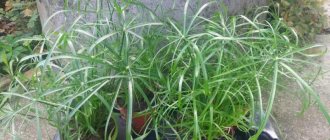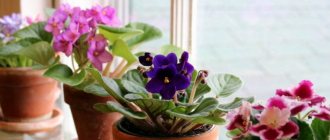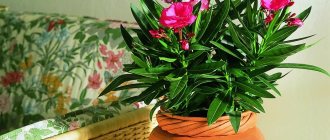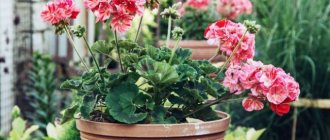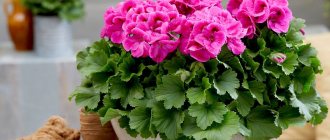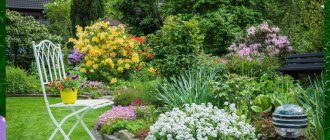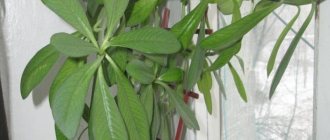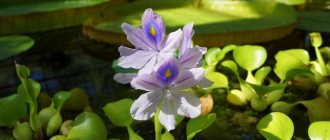Since ancient times, people have been breeding indoor flowers. A variety of plants, blooming in bright colors or having rich greens, decorate the house and give the room grace and coziness. But not every flower can have only a positive effect on household members and their home.
There are also plants that bring grief and unhappiness into the house. Today we will talk about which indoor plants are best not to grow at home. I will list a list of indoor flowers that, even if they grow in the house, only bring destruction, grief and misfortune.
Begonia
This beautiful indoor plant, native to the tropical forests of South America and Central Africa, has taken root in many homes. Bush, tuberous, flowering, decorative deciduous and hanging plant species are known. A characteristic feature of begonias is the presence of a clearly visible vein on the surface of the leaf plate, which divides the leaf into two parts. Begonia leaves can be glossy, matte, velvety, with a silver or bronze tint. Most varieties have simple or double buds of various colors.
According to esotericists, begonia is a kind of indicator of the atmosphere in the house. In families where love and mutual understanding reign, the plant delights with lush foliage and abundant flowering. Drying leaves can be a signal of impending trouble. It is generally accepted that begonia with elongated leaves can have a negative impact on the inhabitants of the house.
Indoor flowers that bring misfortune to the house
Our great-grandmothers never grew flowers in the house, which, according to popular belief, brought grief and misfortune. In addition to bad energy, many of these plants are also poisonous. Accordingly, growing such flowers in the house is very dangerous.
- Ivy. From time immemorial, this plant has been considered negative. Ivy cannot be grown at home, as it can “take away” good energy and vitality from household members. Ivy directs more negativity towards men - the plant gives the masculine character such qualities as a craving for freedom and variability. Accordingly, in a house where ivy grows, the risk that the husband will start going out and cheating on his wife is very high.
- Monstera. The plant belongs to the group of lianas. Monstera, like ivy, “sucks” vitality out of a person. It also negatively affects family well-being. It is believed that if a monstera grows in the house, then there will be constant quarrels and disagreements in the family.
- Ferns. This amazing plant attracts with its beauty. People believed that if you see a flowering fern, you can make a wish, and it will definitely come true. But growing ferns in the house is strictly prohibited. This plant deprives household members of joy and happiness. In addition, ferns have a negative impact on health. It is very dangerous to keep ferns in the bedroom; there is a risk that a person may even die in a dream.
- Dieffenbachia. This indoor tree is poisonous. It is dangerous for the home and all household members. Improper handling of Dieffenbachia can lead to various injuries - from skin burns to severe poisoning.
- Sansevieria (pike tail). The plant is a favorite among flower growers who do not believe in folk superstitions. But people claimed that in a house where a pike tail grows, there will never be family happiness. It is especially dangerous for single people to grow sansevieria, since the likelihood that they will live alone all their lives becomes too high.
- Calla. A graceful plant with amazing delicate flowers can “take away” the joy of household members. The plant “draws in” the good energy of the house, “giving back” the bad energy.
- Mother-in-law's tongue. Another negative plant that is not recommended for unmarried women to grow in the house. Mother-in-law’s language has the ability to “destroy” family well-being. If a flower grows in a married couple, then there will be constant quarrels between the spouses. If a single woman is engaged in growing mother-in-law’s tongue, then finding a life partner will be a real problem for her.
- Cactus. All types of cacti and other forms of succulents cannot be grown at home. Plants can negatively affect family happiness. The cactus brings frequent quarrels, depression, and grief into the house. A family with a cactus on the windowsill will not be happy. Quarrels will constantly occur between spouses. Single women are not recommended to grow cacti, as these plants negatively affect family well-being, and the woman’s risk of being alone increases sharply.
Lily
This perennial bulbous plant resembles a daffodil in appearance, and its delicate aroma has jasmine notes. At home, the height of the flower can reach 40–200 cm. The lily has dense flexible petioles on which oval-shaped leaves are located.
With proper care, the lily blooms 2–3 times a year. At this time, several long hollow peduncles up to 80 cm high are formed on the plant, on which 5–8 flowers bloom. The flowers consist of six petals united into a funnel- or bell-shaped corolla. The diameter of one flower can reach 10–12 cm. Flowers are usually united in umbrella inflorescences.
Lily has strong energy, but it should be remembered that its leaves contain toxic substances that can cause poisoning in people and pets.
Many people consider the lily to be a vampire that absorbs energy. It is no coincidence that many plants next to it grow very slowly or die.
Ivy
In ancient times, ivy was a symbol of devotion, as well as a talisman for all unmarried girls. Ivy helped ladies get married successfully and attracted wealthy and strong men.
Today in post-Soviet territories there is a widespread belief that ivy attracts only misfortunes to life. It is prohibited from being placed in apartments where newlyweds live. Otherwise, the newly made spouse may leave the family.
Fern
An unpretentious ornamental plant is often grown at home. Ferns are characterized by rapid growth, are undemanding in care, and have an attractive appearance. They have short creeping roots and light green leaf plates, collected in basal rosettes. The leaves can be of various triangular or slightly elongated shapes, with wavy edges.
Scindapsus
Scindapsus is popularly called the muzhigon flower.
There is a belief that the vine can affect the relationship of spouses. Families in whose homes the plant lives often and loudly argue. As a result, eternal quarrels lead to divorce and the man leaves home.
Some superstitious ladies claim that scindapsus “drives out” not only husbands, but all males (grandchildren, sons, brothers, etc.) from the house.
Tuberose
Tuberose, or polyanthes, is a herbaceous perennial native to Central America with an attractive appearance. Tuberose has a tall straight stem and dark green velvety leaves up to 40 cm long, collected at the bottom of the shoot. During the flowering period, up to 40 flowers with dense, pointed petals gradually bloom at the top of the stem. They have a delicate, pleasant aroma that intensifies in the evening.
It is believed that tuberose absorbs other people's energy without giving anything in return. In addition, it provokes scandals in the family and betrayal, so growing it at home is undesirable.
Monstera
Monstera is a plant with carved leaves. In China, it is customary to give Monstera to older people to increase the number of days they have left before death.
However, in Russia there is an opinion that this flower is a vampire plant that drinks human energy. It is strictly prohibited for families where people with heart and respiratory diseases live. People are afraid that Monstera will “strangle” them at night.
Hippeastrum
The perennial bulbous plant serves as a real home decoration. The narrow, slightly rough leaves of the plant are arranged in two rows, reaching a length of 70 cm. In the center of each leaf there is a small depression. During the flowering period, the hippeastrum forms a long, powerful peduncle on which large buds bloom. The color of simple or double petals can be different: white, bright red, peach, pink, cream. There may be thin stripes or a border on their surface.
Hippeastrum does not like quarrels and conflicts in the house. The flower absorbs negative energy, giving it back in full later. To avoid a constant influx of negative energy, it is necessary to avoid scandals or get rid of the plant.
Plants and signs
There are also flowers that do not harm anyone, but for some reason they are classified as plants that can foretell the future and indicate future events. People interpret the meaning of colors in different ways.
Rose
It is recommended to grow such flowers for those who are not often at home. The reason is the special impact on humans.
Rose
It turns out that rose affects energy and helps reduce vitality. An already weak person will be weakened even more.
The more pots of roses you have at home, the worse it gets. The best option is to grow such plants outside: in the yard, on the terrace.
Sansevieria
The flower does not fit with male energy. It is not recommended to grow it where a man lives.
Sansevieria Sansevieria
is also not suitable for a lonely girl - it will drive away suitors. Otherwise it is a harmless, beautiful flower.
No one would have thought that it had such an unusual effect on a person.
Let's sum it up
The listed plants have different properties. Moreover, they are all so attractive that you want to arrange a winter garden on your veranda at home or on the balcony of your apartment.
But roses, geraniums, spathiphyllum, dracaena and other flowers can have a negative impact on health.
To prevent the development of allergies, poisoning, and other consequences, you need to know exactly which of them should be grown and which should not.
Oleander
Under natural conditions it grows in regions with warm climates, preferring river beds that dry up during the dry season. This evergreen plant has a developed crown formed by strongly branching shoots covered with narrow long leaves on short petioles. The leaf blade is dark green and has a clearly defined central vein. Oleander attracts attention with its beautiful double flowers, collected in loose semi-umbrella inflorescences. The diameter of one flower can reach 8 cm. More often the petals are white, pink, yellow or red.
Why is it bad if a rose grows in an apartment?
Room
Roses are the flowers of romantics and women of any age. If they are given as a bouquet, they are filled with positive energy. Indoor roses grown in a pot also always delight the eyes of their owners. However, for lush flowering they need positive energy.
Important! People who are rarely at home or lead an active lifestyle are not recommended to keep roses indoors. An open terrace or veranda is the best place for it.
In the video about whether it is possible to grow a rose at home:
Chinese
Particular attention should be paid to the Chinese rose. Most superstitions are associated with it. According to signs, the plant has negative energy. Therefore, if you keep it in the house, it attracts illness, failure and even the death of loved ones.
The flower is especially dangerous during flowering . All the positive energy at home will go into buds.
In the video about whether it is possible to keep hibiscus in the house:
As you can see, there are many signs and superstitions associated with indoor flowers. Some plants bring good luck, peace and love to the family. Others can destroy a marriage or affect the health and well-being of the residents in the house. When choosing a plant for yourself, it is worth studying in detail all its characteristics and signs associated with it.
Stellera dwarf
The plant is widespread in the Far East, Siberia and Transbaikalia, preferring mountain slopes and areas with rocky soil.
Stellera has a thick short stem covered with brown bark and developed numerous shoots. The leaves are long, lanceolate, with a pointed crown. The flowers are small, collected in capitate inflorescences located at the tops of the shoots. The petals are white and have a small red spot on the surface.
The rhizome and above-ground parts of the plant contain organic acids that cause numbness and swelling of the vocal cords.
- Author: Inna Kiseleva
Rate this article:
- 5
- 4
- 3
- 2
- 1
(19 votes, average: 3.9 out of 5)
Share with your friends!
